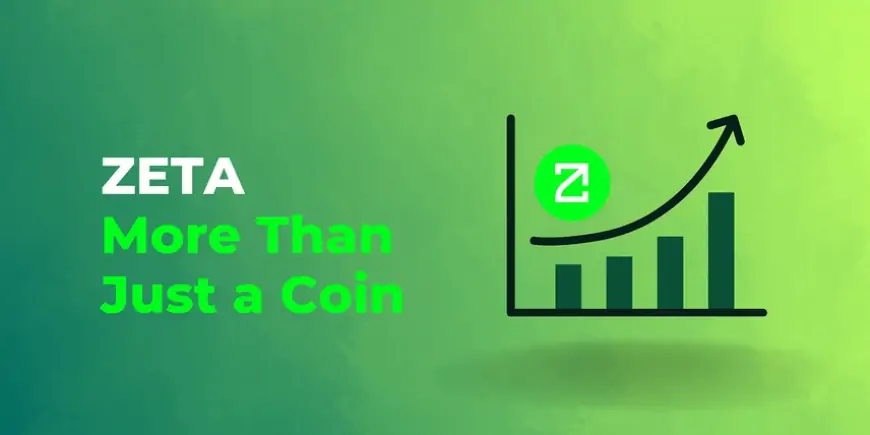What is $ZETA? Zetachain rises following coinbase listing
Zetachain sees a surge in value after being listed on Coinbase. Discover the latest impact and trends surrounding this notable cryptocurrency event.

Layer one (L1) blockchain Zetachain (ZETA) is making headlines with Coinbase's announcement of its native ZETA token listing on the exchange. Previously, Coinbase supported only the ERC-20 ZETA tokens on the Ethereum (ETH) mainnet. The new listing of native ZETA tokens has led to a nearly 25% surge in ZETA’s token price as of August 9, 2024.
What is Zetachain?
Zetachain is a layer one (L1) blockchain designed to address the issue of blockchain fragmentation. Its goal, as outlined in its white paper, is to create a system with “inter-blockchain capability” that avoids the need for external blockchains to conform to different protocols and token standards.
Zetachain enables decentralized applications and users on its platform to interact with other blockchains seamlessly, without relying on cross-chain bridges or wrapped tokens. It achieves this “omnichannel interoperability” through smart contracts that manage assets on external blockchains.
Built using the Cosmos Software Development Kit (SDK) and the Tendermint PBFT consensus engine, Zetachain aims to provide smart contract functionality for Bitcoin (BTC) as part of its interoperability goals. The Zetachain mainnet was launched on January 31, 2024.
Zetachain team
Zetachain was co-founded in 2021 by Charlie Pyle and Ankur Nandwani. Nandwani, known for co-founding Basic Attention Token (BAT), has an extensive background with past roles at Coinbase, Lookout, and Qualcomm. He also co-founded Bitmonet, a Bitcoin micropayment tool, in 2013.
Charlie Pyle, as detailed on his LinkedIn profile, is the co-founder of the payments platform Altro and the crypto startup Hourglass.
In August 2023, Zetachain secured $27 million in funding from investors including Jane Street Capital, Blockchain.com, GSR, Lingfeng Capital, and others.
Zetachain: Key components
- Proof-of-Stake (PoS) Consensus Mechanism: Zetachain operates on a PoS model, where validators are responsible for validating transactions, proposing new blocks, and maintaining the blockchain’s state.
- Observers: Observers are participants within Zetachain who achieve consensus on events and states from external chains. They run full nodes of these external chains to monitor and gather relevant transactions and states at specific addresses.
- Signers: Zetachain uses a system of keys managed by multiple signers to authenticate interactions with external blockchains. These signers are financially motivated to act honestly, and a super-majority of them must agree to reach consensus.
- Zeta Virtual Machine (zEVM): The zEVM is Zetachain’s EVM-compatible execution layer, enabling it to support decentralized applications from Ethereum. It allows smart contracts on zEVM to be invoked from external chains and to create transactions on those chains.
- Omnichain smart contracts: These smart contracts can be called from external chains and manage foreign tokens as if they were native. ZRC20 tokens (equivalent to ERC20 tokens) are used on Zetachain for record-keeping of fungible tokens from other chains.
\What is the ZETA token?
The ZETA token is the native cryptocurrency of the Zetachain ecosystem. It serves several purposes within the network:
- Staking: ZETA is used in staking to support network security and operations.
- Gas fee payment: It is utilized to pay transaction fees on the Zetachain network.
- Governance: ZETA holders can participate in governance decisions, influencing the future development of the platform.
- Cross-chain value exchange: The token facilitates value transfers and interactions between different blockchains within the Zetachain ecosystem.
Next, let's review the tokenomics and key market data for ZETA as of August 9, 2024.
| Metric | Statistic |
| Total initial supply | 2.1 billion tokens |
| Circulating supply | 343.07 million tokens |
| Percentage of circulating supply | 16.3% of the total initial supply |
| Token price | $2.85 (as of February 16, 2024) |
| Market cap | $185 million |
| Market cap to fully diluted valuation ratio | 0.15 |
| All-time high price | $0.3448 (reached on August 5, 2024) |
| Mainnet launch date | January 31, 2024 |
| Fully diluted valuation | $1.13 billion |
Zetachain token price analysis
The ZETA token was introduced alongside the Zetachain mainnet on January 31, 2024.
Following the mainnet launch, Zetachain saw a surge in capital influx, with the total value locked (TVL) increasing from $89,000 on February 2, 2024, to over $5 million by mid-March 2024, according to DeFiLlama data.
In its first month, Zetachain reported that 1.8 million unique addresses interacted with its blockchain.
During this period, the ZETA token reached an all-time high of $2.85 on February 16, 2024.
Since then, however, the price of ZETA has declined. As of now, ZETA is trading at $0.5394, reflecting an 81% drop from its peak value.
Market outlook for ZETA
Looking ahead, the upcoming token unlocks are expected to significantly impact ZETA's short-term price movements.
As previously mentioned, ZETA tokens allocated to core contributors (22.5%) and investors (16%) are being unlocked at a rate of 5.5% of the allocation per month starting August 2024.
According to Token Unlocks, 53.89 million ZETA tokens, representing 15.7% of the current circulating supply, are set to be released on September 1, 2024.
There has been criticism within the crypto community regarding tokens with “low float, high fully diluted valuation,” as these conditions often leave retail investors with limited potential gains. Critics argue that a low initial circulating supply creates artificial scarcity, leading to initial price spikes. However, as token unlocks progress and selling pressure increases, the token price may decline.












































